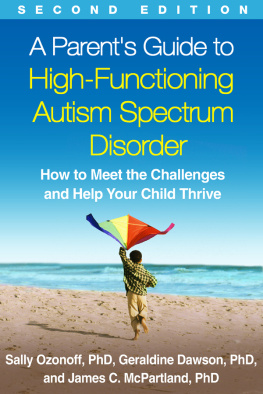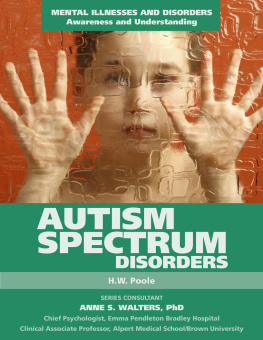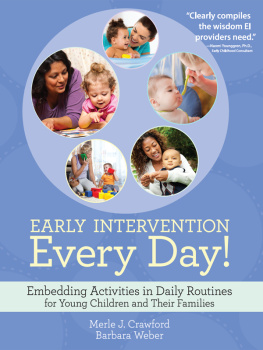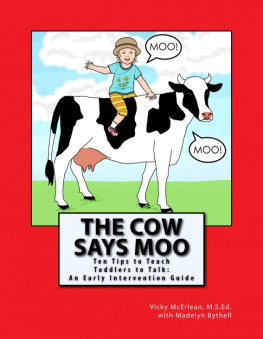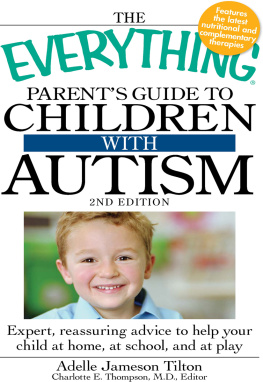For General Readers
A Parents Guide to Asperger Syndrome and High-Functioning Autism:
How to Meet the Challenges and Help Your Child Thrive
Sally Ozonoff, Geraldine Dawson, and James McPartland
For Professionals
Early Start Denver Model Curriculum Checklist
for Young Children with Autism
Sally J. Rogers and Geraldine Dawson
Early Start Denver Model for Young Children with Autism:
Promoting Language, Learning, and Engagement
Sally J. Rogers and Geraldine Dawson
Imitation and the Social Mind: Autism and Typical Development
Edited by Sally J. Rogers and Justin H. G. Williams
Using Everyday Activities
to Help Kids Connect,
Communicate,
and Learn
Sally J. Rogers, PhD
Geraldine Dawson, PhD
Laurie A. Vismara, PhD

THE GUILFORD PRESS
New York London
To all parents of children and adults with autism, for their courage,
their hope, their generosity, and their perseverance
S. J. R.
To my loving husband, Joseph, and my wonderful children,
Chris and Maggie, who have supported my work with patience,
understanding, and a shared commitment to improving the lives
of people with autism
G. D.
To my father, for his commitment to improving the lives
of individuals with autism, and to all the courageous individuals
and their families who are overcoming the challenges of autism
L. A. V.
Epub Edition ISBN: 9781462505074; Kindle Edition ISBN: 9781462505081
2012 The Guilford Press
A Division of Guilford Publications, Inc.
72 Spring Street, New York, NY 10012
www.guilford.com
All rights reserved
The information in this volume is not intended as a substitute for consultation with healthcare professionals. Each individuals health concerns should be evaluated by a qualified professional.
Except as indicated, no part of this book may be reproduced, translated, stored in a retrieval system, or transmitted, in any form or by any means, electronic, mechanical, photocopying, microfilming, recording, or otherwise, without written permission from the publisher.
Last digit is print number: 9 8 7 6 5 4 3 2 1
Library of Congress Cataloging-in-Publication Data is available from the publisher.
ISBN 978-1-60918-470-4 (pbk.)
ISBN 978-1-4625-0389-6 (hardcover)
Contents
Part I
Part II
To protect the identities of the families with whom we have worked, all the stories about families and the examples in this book are composites of real people created to reflect common challenges and successes that we have witnessed many times. The comments from parents scattered throughout the book have been reprinted in their own words with their permission, but their names have been omitted to protect their privacy. We are grateful for their candor and support.
A word about our use of pronouns in this book may also be helpful. In most of the text, we alternate between he and she to refer to your child with autism. However, in items for your personal use (such as forms, boxes, Activity Checklists, and tables), as well as in the , we use he or she.
We want to begin by expressing our deep appreciation for the support we have received from Rochelle Serwator, Chris Benton, and Kitty Moore at The Guilford Press, for motivating and encouraging us, believing in the value of this book, and helping us produce a better one than we would have thought possible. We also want to share our individual acknowledgments.
From Sally:
My preparation for writing this book began with the very first parents and toddlers with whom I worked in Ann Arbor, Michigan. My experiences with children like Laura Ann and Peter, as well as their parents, taught me so much about the first few years of a familys life when a child has developmental disabilities. I appreciate what I learned from them about supporting their relationships, their interactional styles, and their child-raising and family values as they provided interventions for their children. I am extremely grateful to the families in Denver with whom my colleagues and I worked. They are the families from whom I learned not only about early autism and its effects on families, but also about the resilience, hope, and determination of parents to seek out what is best for their childrenwho persist, across years and decades, to improve the quality of their childrens day-to-day lives and prepare themselves and their children for the future. I appreciate all that I learned from my Denver colleagues in the Developmental Psychobiology Research Group about parentchild relationships and measurement approaches, and I appreciate their challenges to me (especially those of Bob Emde and Gordon Farley) to move from clinical services to well-controlled studies of early intervention.
I particularly appreciate what I have learned in the collaborations with my two coauthors, who are also friends and colleagues. Geris work allowed for tremendous growth in the definition and rigor of the intervention approach, and she has been a tireless, enthusiastic, and optimistic partner in our shared work with the Early Start Denver Model (ESDM). Laurie and I together worked out much of the methodology for the ESDM parent training package, which she first studied and published in her postdoctoral research program. The three of us share both belief and experience in the power of parent-delivered interventions embedded in daily routines to teach young children with autism language, play, and social engagement, and these beliefs and experiences were linchpins for developing our research programs in parent interventions and for writing this book.
I also want to thank my two daughters, Sara and Amy, for giving me my only direct experience in parenting toddlers, and for embracing my autism work throughout their lives. My assistant, Diane Larzelere, provided talented and speedy help for manuscript development, and constant cheerful encouragement.
From Geri:
I want to begin by thanking the many parents and children with whom I have had the privilege of working over the past 25 years. They are my true heroes and best teachers. Nothing is as rewarding as sharing the excitement of a new ability being achieved. It has been my delight to watch parents interacting with their young children with autism, drawing them into closer interactions, and helping them learn to communicate and play. It was my privilege to provide suggestions and advice from the perspective of a seasoned clinician and developmental psychologist and then to witness the unfolding of each childs skills over time. Throughout the process of therapy, the persistence, humor, insight, and unconditional love that family members show have been my inspiration.
Early on, my perspectives on autism were shaped by Eric Schopler, Michael Rutter, and Marian Sigman. At a time when other professionals were blaming parents for autism, Eric, a pioneer, showed us that parents are our most important partners, ideally positioned to help their child with autism. Michaels insights about the interface between the social and thinking brain ring truer today than ever and are consistent with the ESDM. Marians landmark studies described the development of autism in exquisite detail, providing a roadmap for creating developmentally informed treatments.
I gratefully acknowledge my graduate students and colleagues at the University of Washington for their openness to new ideas and willingness to pursue them, and for their humor and passion for improving the lives of children with autism and their families. I especially want to acknowledge the hard work of the UW team in completing the randomized clinical trial of the ESDM, which helped lay the foundation for the work discussed in this book.
Next page

